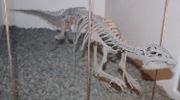Hypsilophodon
2008/9 Schools Wikipedia Selection. Related subjects: Dinosaurs
| Hypsilophodon Fossil range: Early Cretaceous |
||||||||||||||||||
|---|---|---|---|---|---|---|---|---|---|---|---|---|---|---|---|---|---|---|
 Hypsilophodon skeleton at Oxford University Museum of Natural History.
|
||||||||||||||||||
| Scientific classification | ||||||||||||||||||
|
||||||||||||||||||
| Binomial name | ||||||||||||||||||
| Hypsilophodon foxii Huxley, 1869 |
Hypsilophodon (pronounced /ˌhɪpsɨˈlɒfoʊdɒn/; meaning 'high-crested tooth') is an ornithopod dinosaur genus from the Early Cretaceous Period of Europe. It was a small bipedal animal with an herbivorous or possibly omnivorous diet. Abundant fossil remains found in England indicate that Hypsilophodon reached about 2 meters (6.5 feet) in length.
Discoveries and species
The first remains of Hypsilophodon were recovered in the early days of paleontology in 1849. However, at the time, the bones were thought to belong to a young Iguanodon. It was not until 1870 that paleontologist T. H. Huxley was able to publish a full description of Hypsilophodon as we know it today. He had been provided with a number of skeletons by the Reverend William Darwin Fox, after whom the first species of Hypsilophodon was named.
Early paleontologists modeled the body of this small, bipedal, herbivorous dinosaur in various ways. In 1882 some paleontologists suggested that, like a modern tree-kangaroo, Hypsilophodon was able to climb trees in order to seek shelter. This was the accepted view for almost a century. However, Peter M. Galton finally performed more accurate analysis of the musculo-skeletal structure in 1974 and convinced most paleontologists that Hypsilophodon remained firmly on the ground.
Since then, three near-complete and over twenty minor finds have been made, especially on the Isle of Wight, off the south coast of England. Other finds have been made in southern England, Portugal and South Dakota, USA.
There is only one known species of Hypsilophodon, Huxley's original H. foxii. Galton and Jensen named another species, H. wielandi in 1979, but it now seems likely this was just a variant individual within H. foxii.
Paleobiology
Hypsilophodon was a relatively small dinosaur. While not quite so small as, for example, Compsognathus, Hypsilophodon was only around 2.3 metres in length. It would have reached approximately waist-height on a modern man and would have weighed about the same, at 50-70 kg.
Like most small dinosaurs, Hypsilophodon was bipedal and ran on two legs. Its entire body was built for running; a light-weight, minimized skeleton, low, aerodynamic posture, long legs and stiff tail for balance all would have allowed it to travel remarkably fast for its size.
Due to its small size, Hypsilophodon fed on low-growing vegetation, most likely preferring young shoots and roots in the manner of modern deer. The structure of its skull, with the teeth set far back into the jaw, strongly suggests that it had cheeks, an advanced feature that would have facilitated the chewing of food. There were twenty-eight to thirty ridged teeth in the animal's jaw which, due to their alternate arrangement, appear to have been self-sharpening. As in almost all dinosaurs and certainly all the ornithischians, the teeth were continuously replaced.
The level of parental care in this dinosaur has not been defined, although a neatly-arranged nest has been found, suggesting that some care was taken before hatching. Fossils of large groups have been found, so it is likely that the animals moved in herds. For these reasons, the hypsilophodonts, particularly Hypsilophodon, have often been referred to as the "deer of the Mesozoic".
Despite living in the last of the periods in which dinosaurs walked the earth, the Cretaceous, Hypsilophodon had a number of primitive features. For example, there were five digits on each 'hand' and four on each foot. Most dinosaurs had lost these redundant features by the Cretaceous period. Also, although it had a beak like most ornithischians, Hypsilophodon still had pointed triangular teeth in the front of the jaw. Most herbivorous dinosaurs had, by this stage, become sufficiently specialized that the front teeth had been altogether lost (although there is some debate as to whether these teeth may have had a specialized function in Hypsilophodon).
The group Hypsilophodontia remained remarkably static from the late Jurassic to the end of the Cretaceous. It is possible that this was because the animals were almost perfectly adapted to their lifestyle, therefore selective pressure, it is assumed, was low.

